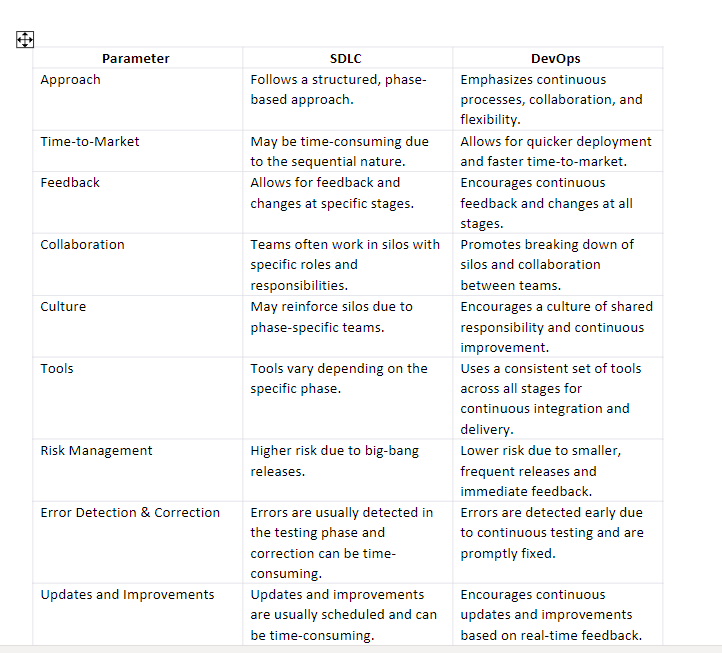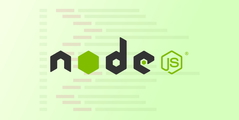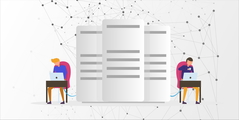In the dynamic world of software development, understanding the path from conception to delivery is pivotal. The Software Development Life Cycle (SDLC) and DevOps are two leading methodologies that streamline this process. This article offers an in-depth analysis of both, unveiling their models, stages, benefits, limitations, and applications. By the end, you'll have a clearer picture of which approach suits your business needs best.
What is SDLC?
At the heart of any software project is the Software Development Life Cycle (SDLC), a structured process that guides the production from initial requirement gathering to the final deployment. SDLC ensures the delivery of high-quality software within a specified budget and time frame while mitigating potential risks.
Types of SDLC Models
Software development isn't one-size-fits-all. SDLC adapts to the varying needs of businesses through several models, each with its unique approach.
Waterfall Model
The Waterfall Model, the oldest SDLC type, is a linear and sequential approach. It starts with requirement gathering and proceeds downwards through design, coding, testing, deployment, and maintenance. Changes aren't welcome once a stage is completed, making it suitable for projects with stable requirements.
Agile Model
In stark contrast, the Agile Model embraces changes, fostering constant collaboration and customer feedback through iterative development. Projects are broken into "sprints," with each delivering a usable part of the software. Agile is favored for its flexibility in today's fast-paced tech world.
Iterative Model
The iterative model involves building software incrementally, starting with simply implementing a subset of the software requirements and iteratively enhancing the versions until the full system is implemented.
Spiral Model
The Spiral Model blends the rigid waterfall model with the flexible, iterative approach. It starts small, gradually increasing features and complexity with each iteration, with a risk analysis before every phase.
V-shaped Model
The V-shaped Model, an extension of the waterfall, emphasizes verification and validation. Each development stage has a corresponding testing phase, ensuring high product quality.
Stages of SDLC
Each stage of the SDLC is a cog in the wheel of software development, crucial in maintaining order and efficiency.
Requirement gathering and analysis
This stage forms the foundation of the project. Business analysts gather requirements from stakeholders and document them in a detailed, unambiguous manner. According to the Standish Group's CHAOS Report, 71% of software projects fail due to poor requirements gathering, underlining the importance of this stage.
Design
Once requirements are set, system architects and designers translate these into a technical blueprint, addressing hardware, software, and system requirements. They employ tools like flowcharts and data-flow diagrams to map out the design.
Implementation of coding
In this stage, developers turn the design into code using the appropriate programming language. This stage often consumes most of the project's time, with a study revealing that coding accounts for roughly 53% of the total project time.
Testing
Quality Assurance (QA) teams test the software against the initial requirements, hunting for defects and inconsistencies. In 2020, the Capgemini World Quality Report found that businesses dedicate about 25% of their IT budgets to testing, highlighting its significance.
Deployment
The software is deployed to the production environment after the testing phase. Some companies choose to release it to a limited user base first, a strategy known as beta testing.
Maintenance
Post-deployment, any modifications, upgrades, or repairs fall under maintenance. It's important to note that maintenance can consume about 75% of the total cost of ownership, according to a study by CAST Software.
Benefits of SDLC
Exploring the numerous advantages, let's delve into the Benefits of SDLC.
1. Clarity and predictability
The precise structure of SDLC allows for predictability and understanding of the timeline and requirements. This helps stakeholders understand the expected outcome, timelines, and associated costs.
2. Quality assurance
By incorporating testing as a primary stage, SDLC ensures the end product is high quality. This process reduces the risk of errors and bugs in the final product.
3. Documented process
Every phase in the SDLC requires documentation, resulting in a thorough record of the software development process. This can be useful for future improvements or for onboarding new team members.
4. Risk management
SDLC incorporates risk management into every stage, helping prevent potential issues before they become significant problems.
5. Control
With distinct phases and outcomes for each stage, managers have better control over resource allocation and project progression.
Limitations of SDLC
Before proceeding further, it's crucial to understand the Limitations of SDLC that might impact development processes.
1. Limited Flexibility
Traditional SDLC models, like the Waterfall Model, are linear and do not easily allow changes or revisions once a stage is completed. This rigidity can be problematic when unexpected changes or new requirements come up.
2. Time-Consuming
SDLC can be long, especially since each stage must be completed before the next begins. This is better for projects with tight deadlines or requiring rapid deployment.
3. Dependent stages
The success of each stage is dependent on the preceding one. Any mistakes or overlooked details in an earlier phase could impact subsequent phases, leading to potentially extensive revisions.
4. Costly maintenance
A significant portion of the total cost of ownership goes into maintenance. Post-deployment changes or fixes can often be expensive and time-consuming.
5. Limited user involvement
In traditional SDLC, users see the product once it's almost completed. This might lead to situations where the final product needs to meet user expectations.
What is the DevOps Lifecycle?
DevOps, a portmanteau of 'Development' and 'Operations,' signifies a cultural shift in software development, focusing on continuous collaboration between development, testing, and operations teams. The DevOps lifecycle is an endless loop aimed at constantly improving and rapidly deploying high-quality software.
Stages of the DevOps Lifecycle
The DevOps Lifecycle comprises the following stages:
Continuous Development
This is the stage where the actual coding of the software takes place. Unlike SDLC, there is no separate requirement-gathering phase in DevOps. Changes and updates are part of the ongoing process.
Continuous integration
Continuous integration involves regularly merging all developer working copies to a shared mainline. This practice enables early detection of integration bugs, improved communication, and reduced integration problems, allowing for more rapid software development.
Continuous testing
Automated tests are conducted in this phase to ensure the code is error-free. According to a Forrester report, automated testing can save up to 20% of testing time and increase test coverage.
Continuous deployment
In this phase, the code is deployed to the production servers. All code changes are automatically tested and prepared for production release, ensuring every successful transition to the application is releasable.
Continuous monitoring
In this final stage, system performance is monitored. Feedback is collected and used to identify future improvements, creating a loop of continuous enhancement.
Research suggests that the constant feedback inherent in DevOps can reduce the time to identify faults by up to 48%.
Benefits of DevOps lifecycle
As we navigate the world of software development, it becomes evident that exploring the Benefits of DevOps Lifecycle can significantly enhance efficiency and collaboration.
1. Rapid deployment and speedy innovations
DevOps emphasizes continuous development, integration, and deployment, allowing faster innovation and speedy deployment of solutions.
According to a DORA report, high-performing DevOps organizations deploy 208 times more frequently than low performers. This frequent release cycle enables organizations to outpace competitors and adapt to market changes rapidly.
2. Improved collaboration and communication
DevOps fosters a shared responsibility and collaborative work culture, breaking down the traditional silos between development and operations teams. This seamless communication and collaboration lead to higher efficiency and productivity.
3. Enhanced quality and reliability
Through continuous integration, testing, and monitoring, DevOps ensures the reliability and quality of the software. Automated testing and integration make sure errors are detected early and fixed promptly.
As per a survey by Atlassian, teams practicing DevOps experience 22% less time on unplanned work and rework.
4. Efficient problem-solving
With continuous monitoring and immediate feedback, issues are identified and addressed quickly. This leads to faster recovery from downtime and efficient problem-solving.
5. Cost and time efficiency
Automation in the DevOps lifecycle eliminates manual tasks, leading to cost savings and more efficient use of resources.
According to an Accenture report, DevOps practices can reduce software delivery times by 50% and lower costs by 20%.
Limitations of DevOps Lifecycle
While DevOps Lifecycle has revolutionized software development, it's essential to be aware of the Limitations it presents to effectively address potential challenges.
1. Cultural and organizational shift
Implementing DevOps involves significantly shifting company culture and workflow. It requires teams to move from working in silos to a more integrated approach. This often meets resistance and takes time to be fully embraced by all stakeholders.
2. Complexity
DevOps introduces high complexity into the development process, with more frequent releases and tighter team integration. This can lead to increased risks and issues if not appropriately managed.
3. Need for continuous monitoring and feedback
Making DevOps effective requires constant monitoring, feedback, and adjustments. This might be demanding regarding time and resources, especially in larger organizations.
4. Dependency on tools
DevOps heavily relies on the use of automation tools. If these tools fail or have security flaws, it can significantly impact the development process.
5. Skill requirements
DevOps requires team members to have a diverse skill set, including knowledge of software development, operations, testing, and familiarity with various DevOps tools. Acquiring or training for these skills can be a challenge.
SDLC vs. DevOps: A comparative analysis
In order to gain deeper insights into software development methodologies, let's embark on a comparative analysis between SDLC and DevOps.
Differences between SDLC and DevOps

Scenario-based comparison: When to use SDLC?
By examining different scenarios and practical applications, we can determine the optimal situations to employ SDLC in software development.
1. Project's scope and requirement stability
SDLC is suitable when project requirements are clearly defined and expected to remain stable throughout the development process.
2. Legacy systems maintenance
SDLC can be effective for projects involving legacy systems, where modifications are made more systematically and structured.
3. Fixed budget and time constraints
When working within a fixed budget and timeline, the structured nature of SDLC allows for better planning and control over resources.
When to use DevOps LifeCycle?
Understanding the ideal contexts and project requirements will guide us in making informed decisions on when to leverage the benefits of DevOps Lifecycle in the software development process.
1. Fast-paced development
With its continuous integration and deployment, DevOps is ideal for projects requiring frequent updates and a fast-paced development process.
2. High collaboration and transparency requirements
Projects that require close collaboration between teams, particularly between developers and IT operations, benefit from the DevOps approach.
3. Continuous improvements and updates
If the software requires continuous updates and improvements based on user feedback, DevOps allows for quick changes and continuous enhancement.
Factors to consider for your business
When deciding between SDLC and DevOps, evaluating your business's specific needs and circumstances is essential. Here are some factors to take into account:
1. Size of your business
Larger businesses may lean towards SDLC due to its structured nature that can efficiently manage a large volume of work and resources. However, small to medium-sized companies may benefit from DevOps' flexibility and rapid release cycles, fostering innovation and responsiveness.
2. Nature of your business
DevOps may be more appropriate if your business is based mainly on software development with frequent requirement changes and a need for speedy updates.
However, SDLC might be a better fit for companies with more stable requirements and a greater need for meticulous planning and risk management.
3. Speed of delivery
With its continuous delivery approach, DevOps enables faster product releases to the market, making it suitable for businesses operating in highly dynamic and competitive environments.
4. Quality assurance requirements
Both SDLC and DevOps emphasize quality but in different ways. SDLC does this through a dedicated testing phase, while DevOps incorporates quality assurance throughout its continuous integration and delivery process.
5. Flexibility for changes and updates
DevOps will be preferred if your business demands frequent changes and updates due to its inherent ability to rapidly integrate and deploy new changes.
Case Studies of SDLC and DevOps Lifecycle
Examining real-world Case Studies of SDLC and DevOps Lifecycle implementations will shed light on their practical applications and effectiveness in different software development projects.
Successful implementation of SDLC
Consider the case of the NASA Space Shuttle Program. The space shuttle was one of the most complex systems ever built and managed. With a development process that spanned decades, the program successfully delivered a reusable space vehicle by meticulously applying a Waterfall-based SDLC.
Each program phase, from requirement analysis to deployment and maintenance, was delineated and methodically executed. This rigorous structure and disciplined approach minimized risk and was instrumental in the program's success. In particular, the project achieved its aim of reusability, with each shuttle designed to fly up to 100 missions, a feat unmatched by any previous space vehicle.
Successful implementation of DevOps
One of the most compelling examples of successful DevOps implementation comes from Netflix. In an industry where speed and responsiveness are vital to staying competitive, Netflix has emerged as a pioneer in employing DevOps principles.
Netflix's in-house tool, Spinnaker, enables continuous delivery, which is critical for the company to update its services frequently and swiftly. The platform handles over 1,000 deployments per day without significant downtime. Netflix also utilizes Chaos Monkey, another in-house tool that randomly terminates virtual machine instances during regular business hours to ensure the system can tolerate such failures.
This continuous development, integration, testing, and deployment approach allows Netflix to provide seamless streaming experiences to over 200 million subscribers worldwide, despite the variations in traffic and the constant updates to its content and features.
Conclusion
This article explores two important software development methodologies: the traditional Software Development Life Cycle (SDLC) and the innovative DevOps Lifecycle. SDLC is suited for projects with stable requirements, following a structured, phase-wise approach, while DevOps emphasizes continuous development, integration, testing, deployment, and monitoring for businesses needing agility and frequent updates.
The NASA Space Shuttle Program successfully used SDLC's Waterfall-based approach to deploy a complex and reusable space vehicle. In contrast, Netflix effectively employs DevOps principles to manage numerous daily deployments and provide a seamless streaming experience to millions.
However, many businesses now adopt a hybrid approach, combining elements of both SDLC and DevOps to meet their specific needs. When choosing between the two, understanding business requirements, project nature, business size, delivery speed, quality assurance needs, and flexibility for changes is crucial. The decision is not one-size-fits-all and should be carefully considered based on individual business needs and objectives. The goal is to select the methodology that works best for the business, not necessarily the "best" one according to conventional standards.
As the saying goes, "The best system is the one that works best for you.
Unlock the power of software development: Explore SDLC and DevOps with Rapidops
Discover the benefits of SDLC and DevOps methodologies in software development with Rapidops! Learn about their unique features, successful case studies, and factors to consider when choosing the right approach for your business needs. For expert guidance and assistance, contact Rapidops today!
FAQs (Frequently Asked Questions)
To address common queries and provide comprehensive insights, we've compiled a list of frequently asked questions (FAQs) related to SDLC and DevOps Lifecycle.
Which SDLC model is best for business?
Which SDLC model is best for business?Does DevOps replace an SDLC?
Does DevOps replace an SDLC?Q3. Why is SDLC the best option?
Q3. Why is SDLC the best option?What is the critical advantage for a business to follow the SDLC?
What is the critical advantage for a business to follow the SDLC?Q5. Which SDLC model is best for big projects?
Q5. Which SDLC model is best for big projects?Which process model is best and why?
Which process model is best and why?When should DevOps not be used?
When should DevOps not be used?

Niyati Madhvani
A flamboyant, hazel-eyed lady, Niyati loves learning new dynamics around marketing and sales. She specializes in building relationships with people through her conversational and writing skills. When she is not thinking about the next content campaign, you'll find her traveling and dwelling in books of any genre!

Let’s build the next big thing!
Share your ideas and vision with us to explore your digital opportunities
Similar Stories
- Engineering
- undefined Mins
- September 2022

- Engineering
- undefined Mins
- January 2016

- Engineering
- 5 Mins
- November 2015


Receive articles like this in your mailbox
Sign up to get weekly insights & inspiration in your inbox.
